|
|
|
|
Products mentioned in this Article
--None--
|
|
|
|
|
|
|
|
|
 |
|
|
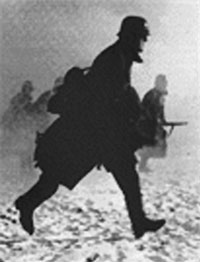 |
V. The Juggernaut Strikes – A Day-by-Day Account
By Wolf Höpper
V.3. 21 November
Return to 20 November...
After the 376. Infanteriedivision had established the new defensive line it became clear, after the most forward elements of the Soviet 4th and 26th Tank Corps reached the Ossinovskiy – Ostrov line, that the rear area of 6th Army around Golubinskiy was highly vulnerable.
|
|
Therefore General Strecker, commander of XI Army
Corps, planned to move some of his divisions to this sector and block
the possible Soviet advance. He could do this because the 44. and 376.
Infanterie divisions were not too seriously threatened from the
pursuing Soviet forces and the 14. Panzerdivision was still holding
around Businovka-Businovka.
It was planned to refit the I/Panzergrenadier Regiment 21 at the maintenance area and move them, together with the 1st/Panzer Pioneer Battalion 40, to the new assembly area of 24. Panzerdivision.
The chaotic situation during the following days rendered this plan unfeasible and both units were held at Kalach where they participate in the fighting against the Soviet bridgehead. Later both units were pushed southwards and out of the cauldron. Many of their survivors later form the nucleus of newly raised units after the original 24. Panzerdivision was destroyed at Stalingrad.
|
During the night the thermometer drops to -26 degrees Celsius and the Don River freezes completely. Raging snowstorms limit the visibility to less than 10 meters at times. The snow blanket, which melted during the previous day, was frozen to ice. This proved a problem that hindered the German force’s movement in the following days.
At midnight, after the Soviets received tank support and started to attack from the west and southwest, the cavalry of 8th Cavalry Corps finally captured the town of Pronin after a fierce night battle.
|
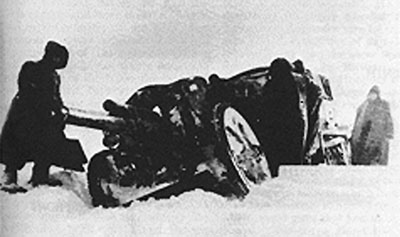 |
|
The Romanian 7th Cavalry Division was forced
again to retreat and, unable to withdraw its artillery, they leave 18
guns behind robbing them of their supporting artillery.
The 1st Tank Corps continued its advance towards the Bolshaya Donshchinka – Russkaya Sloboda line. After they approached the Bolshaya Donshchinka area, the tanks received anti-tank fire from the 22. Panzerdivision, whereupon the corps moved southwest to avoid the fight. The connection between 1st Tank Corps and 8th Cavalry Corps was lost. General Heim cannot react to this situation properly and the possible isolation of the 1st Tank Corps cannot be taken advantage of.
Verkhne-Buzinovka was attacked by the 6th Guards Cavalry Division and the subordinated 18th Guards Cavalry Regiment at 0400 hours. Here two battalions and 27 panzers of 14. Panzerdivision defended. The fighting was intense, but 14. Panzerdivision’s counterattacks to retake the town were unsuccessful. The Soviet cavalry retreats once they realised an unhindered advance here seemed unlikely.
|
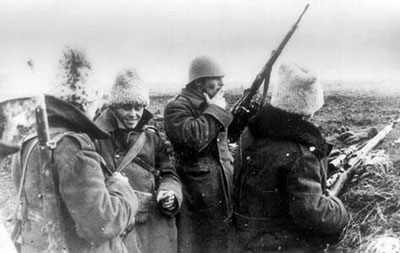 |
Afterwards the Soviets shifted the 6th Guards Cavalry Division, while leaving screening forces, and encircled the State Farm from the south. The 32nd Cavalry Division followed behind and advanced towards Osinovka. Here they encountered elements of the 14. Panzerdivision battle group, namely the divisional staff with its organic combat elements.
The 197th and 65th Cavalry Regiments were assigned for the direct assault against Verkhne-Buzinovka. As soon as the 32nd Cavalry Division moved south, the Germans counterattacked out of the Farm.
|
|
The attack didn’t succeed, and the 14.
Panzerdivision was forced to retreat towards Osinovka. The small
village was finally seized by the Soviets. The 197th Cavalry Regiment
inflicted 100 dead and captured another 19 German soldiers in the town.
The advance of the 3rd Guards Cavalry Corps to the southeast continued during that night. Around 0500 hours the 5th Guards Cavalry Division arrived around Nizhne-Buzinovka and was immediately attacked by German aircraft. The cavalry scattered in all directions so the losses were insignificant.
At dawn in the southern Soviet attack sector the remnants of the defending Romanian 1st and 4th Infantry and 5th Cavalry divisions were driven back from their positions between Plodovitoye and Abganerovo by units of the 4th Cavalry Corps.
|
Having realised that the breakthrough was still not complete the Soviet 5th Tank Army orders their 124th and 119th Rifle Divisions to attack southeastwards to link up with the 21st Army and widen the existing breakthrough.
The Romanians established an all-around defence at Raspopinskoye. Here they hold against the Soviet rifle divisions from the 5th Tank and 21st Army.
At 0600 hours the 20th Guards Cavalry Regiment attacked the positions of the 24. Panzerdivision and were met by stiff resistance from two infantry companies at Nizhne-Buzinovka. The Germans were driven off the State Farm, but counter-attacked at 0930
hours with 15 panzers and a company of Panzergrenadiers (submachine
gunners) out of Sukhanovskiy.
|
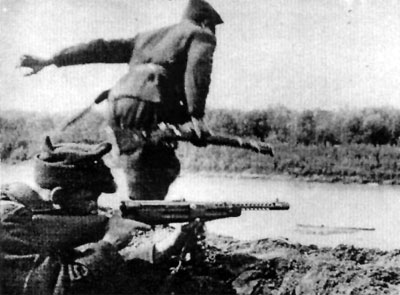 |
|
In the pursuit following the repelling of
the German attack, the cavalry regiment captured Sukhanovskiy at 1600
hours. Another counterattack by six German panzers at 1800 hours was
also successfully repelled.
In the morning of that day the 19th Tank Brigade finally joined the rest of the 26th Tank Corps at Perelazovskiy. The infantry of 1st Tank Corps was still trying to overthrow the Romanian defence at Peshanyi (Ust-Medvetskiy).
At other points on the Soviet advance routes, the mechanized units encounter resistance. The leading elements of the transferred 16. Panzerdivision were already assembled, and their officers evaluated the information they have received. Suddenly the forward elements of Panzer Regiment 2, 16. Panzerdivision, received enemy tank fire. The Soviet 4th Tank Corps had already reached Suchanov and the Liska River and was advancing from the west towards Kalach. The panzers of the division had driven right into the advancing Soviet tank forces. After a brief, but intense, fire-fight, the Germans were forced to retreat and tried to establish a defensive line at the river southwest of Golubinka. Shortly after the column reorganised, the order was revoked and the old attack route had to be resumed.
|
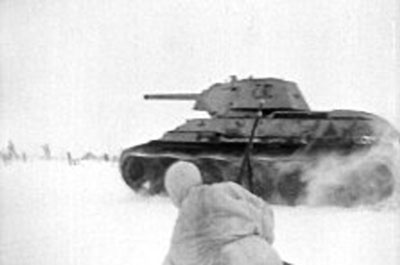 |
This time, the road was clogged by retreating Romanian artillery and cavalry units, intermingling with the 16. Panzerdivision combat group and other allied troops. After an hour, the combat group radioed the divisional staff and realised that the order to retreat was not given by them! Several radio transmissions with the XIV Panzer Corps also proved fruitless. The source of this mysterious radio order is still unknown. The division’s officers even thought some kind of deception in their own ranks was possible.
The combat group moved towards the north and tried to establish a cohesive defensive line at Bolshaya – Nabatovskiy. But the strong enemy forces were immediately pressuring them.
|
The hastily established Kampfgruppe Dormann (I/Panzergrenadier Regiment 64 and Kradschützen Battalion 16) tried desperately to throw back the enemy forces of the 4th Tank Corps. The panzers repulsed an enemy cavalry regiment’s attack. The front held and the Soviets didn’t try again to cross the Don River here. The 9th/Panzer Regiment 2 lost ten panzers in the defence.
On the left flank of 5th Tank Army the Romanians undertook several counterattacks. They were so successful here that the capture of Korotkovskiy and Shirk by the Soviets, scheduled for the first day, was delayed until the evening of 22 November. The Soviet schedule was already behind, and the planned goals were either not met or had been costly to meet. The 8th Cavalry Corps was held around the Chir River by hard fighting Romanian units. Therefore the planned advance of the 21st Army was basically stopped and its units were used to broaden the breakthrough areas for the long due drive through of the 1st Tank Corps of 5th Tank Army.
|
The Soviet 21st Cavalry Division was detached from 8th Cavalry Corps and directly subordinated to 5th Tank Army. The division was ordered to annihilate the retreating remainders of the 7th, 9th and 14th Romanian Infantry Divisions around Rubaskin, Singin and Gorbatovskiy.
During the day the 21st Cavalry Division attacked out of Karaseev and advanced towards the Frunza State Collective Farm No. 2. They were counterattacked three times by the 9th Romanian Infantry Division.
|
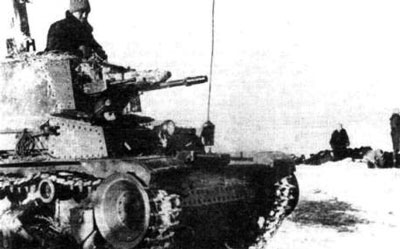 |
By the morning parts of the 8th Cavalry Corps were engaged with enemy forces of the V Romanian Army Corps. This corps was reinforced by tanks of the 1st Romanian Armoured Division. The 112th Cavalry Division attacked out of the Bolshaya Donshchinka area against a Romanian infantry regiment supported by 25 tanks of the 1st Romanian Armoured Division. The Romanians retreated towards Medvezhiy. The 55th Cavalry Division captured Malaya Donshchinka on the march and fought against the stubborn resistance of the Romanian 14th Infantry Division. The Romanians held Bolshaya Donshchinka fiercely, and the fight lasted for the whole day.
The 47th Guards Rifle Division pursued the retreating Romanian units and captured Varlamov. Thereafter they resumed their advance in the direction of Chernyshevskaya. The left flank units of the 8th Cavalry Corps were engaged by the German 22. Panzerdivision around Peshanyi and made only slow progress in that sector.
|
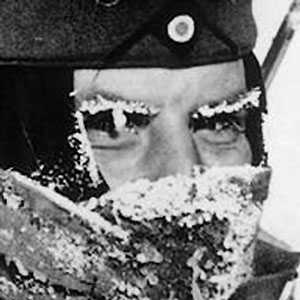 |
The German 22. Panzerdivision undertook an attack in a northeastern direction, but was surrounded. An attack from their southeast was able to block their rear area and the units of 8th Cavalry Corps and 26th Tank Corps nearly encircled them. A fierce fight between the 22. Panzerdivision and elements of the 8th Cavalry Corps ensued, and 22. Panzerdivision’s Panzer Regiment 204 was quickly reduced down to a single company of operational panzers. Later the division fought its way out of this dangerous situation and retreated south-westwards to Chernysochotskiy. During the retreat they were constantly harassed by the Soviet 8th Cavalry Corps.
At 0740 hours the 6th Army headquarters sent a rather optimistic situation report to the headquarters of Army Group B, where Paulus and Schmidt still considered the thrust of the 3rd Guards Cavalry Corps against XI Army Corps as the main threat. After a report that Soviet tank columns advanced
only 30 kilometres west of the Army’s headquarters, they were finally
convinced that the main axis of advance was further west.
|
|
Unfortunately
no German reserves or substantial troops were available there. Large
supply and fuel stocks were falling into the hands of the advancing
Soviet forces. The German generals realised that both of the diagonally
aimed advances were poised for Kalach. The encirclement of their Army
becomes obvious.
Until that day the headquarters of the 6th Army was located at Golubinskaya, but at 1400 hours Soviet tank units reached the area. General Oberst Paulus and his second in charge, General Major Schmidt, escaped in some nearby Fieseler Storch airplanes, which evacuated them to Nizhna-Chirskaya. This was intended winter headquarters of the 6th Army.
At 0830 hours Abganerovo was reached by the Soviet 4th Cavalry Corps. They were immediately attacked by mounted Romanian cavalry of the 6th Cavalry Regiment. After a brief fight the town was captured. The corps’ horses were tired and the men weary, so a further pursuit of the retreating Romanians was aborted. The 277th Regiment of 81st Cavalry Division continued to advance and captured Abganerovo Station at 1200 hours.
The 1st Tank Corps was still held up fighting enemy resistance in front of them. Only the 26th Tank Corps gained further ground and advanced further forward. On their way they reach Dobrinka, where the commanding staff of the 6th Army rear area, Korück 593, was located. This command staff was established on 20 October to secure the rear area of 6th Army. Nominally the commander, General von Rothkirch, had the following units for securing the vital areas:
|
Reserve Division 403 with
Infantry Regiment 354
II/Reserve Police battalion 8 (motorized)
Cavalry Regiment 403 (Cossacks, cavalry)
1 platoon of armoured cars
1 signals company
3000 men of the border security forces to secure economical important objects
Security Battalion Wacht Battalion 571
Bicycle Security Battalion B
Military Police (motorised) battalion 521
Military Police (motorised) battalion 551
3 groups of general field police
|
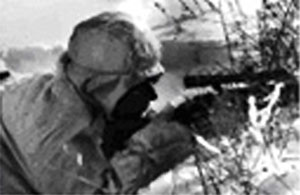 |
After the enemy forces at Dobrinka were engaged as best as the weak defence allows, Korück 593 retreated with remnants of their troops to Surovibino, where they combine with Kampfgruppe von Stumpfeld and reinforce the defence there.
The 26th Tank Corps advanced rapidly and reached the Plestiskovskiy-Ostrov line. This operation opened a 30 to 40 kilometre gap between these two attacking tank corps, resulting in a situation where the 26th Tank Corps was very vulnerable to being cut off.
|
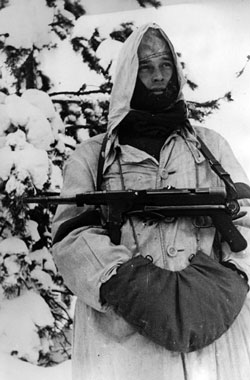 |
Several days before the Soviet attack the repair and replacement facilities of Panzer Regiment 36 (14. Panzerdivision) at Akssay raised a company of panzer crews with no tanks. The division, after transferring parts of their combat units to meet the upcoming threat, informed the commander of I/Panzer Regiment 36, Major Sauvant, that he and his men might be needed. So under his direction, an infantry company with about 150 men was raised. The commanding officer was Oberleutnant Jauch. In addition, 8 panzers left the workshops there and were assembled as panzer company Wohlleben. After the breakthrough on the southern sector became known, Kampfgruppe Sauvant advanced towards height 146.5 near Abganerovo. Shortly after midday, the rest of the 6th Army staff was evacuated to Gumrak, where the new HQ was established.
During the early afternoon Kampfgruppe Don reaches Kalach. They were unable to cross the bridge since the road was blocked by retreating German and Romanian vehicles. The chaos was increased by rumours that the Soviets were only a few kilometres away. In reality the Soviet 1st Tank Corps was still more than 60 kilometres away from Kalach. The 26th Tank Corps was still advancing towards Dobrinka and Lobosinskiy. Only the energetic efforts of some battle hardened German officers and the threat to shoot the fleeing Romanian and German soldiers, enables the kampfgruppe to cross the bridge and kept them on the march.
|
|
The designated assembly area was reached around midnight. Only the armoured cars remained stuck in the traffic jam.
During the afternoon Kampfgruppe Sauvant engaged forward elements of
the Soviet 4th Cavalry Corps. The slightly faster advancing panzers,
together with gathered Romanians from the shattered 1st Infantry
Division, finally repulsed the Soviet forces. During the night the
kampfgruppe was shifted to north of Gontsharovskiy as a reserve of the
4th Panzer Army.
Since the 26th Tank Corps was basically the only uncommitted Soviet mechanised unit, the commander of 5th Tank Army ordered them to advance towards Kalach. The right flank rifle and cavalry divisions reached the area around Gorbatovskiy and immediately attacked that village. The fighting lasted until midnight. The retreat of the German and Romanian units enabled the 21st Army to advance southwards.
|
After severe fighting, the remaining units of 16. Panzerdivision finally reached their ordered positions north of 14. Panzerdivision. The positions were as follows from left to right:
Battalion Wota (I/Panzergrenadier Regiment 79)
Battalion Dörnemann (I/Panzergrenadier Regiment 64)
APC Company Oberleutnant Dietz
Combined kampfgruppe of the remaining forces under Hauptmann Strack
The panzer regiment - in reserve
|
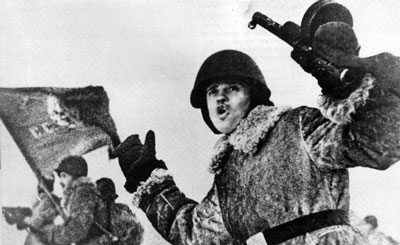 |
Shortly thereafter, the panzer regiment and Kampfgruppe Strack crossed the eastern bank of the Don and attacked the Soviet 6th Guards Cavalry Division and 32nd Cavalry Division near Dmitriyevka. The Soviet anti-tank defence proved too strong and the German battlegroups had to retreat towards Evlembrovskij. Later the 6th Guards Cavalry Division and 32nd Cavalry Division captured Osinovka at 1400 hours. Here they were forced to rest for four hours, since men and horses alike were totally exhausted. Any further advance on the day was totally impossible.
|
Results of the third day
The northern German armoured group, consisting of the German 22. Panzer and Romanian 1st Armoured divisions, was holding up the majority of the Soviet 1st Tank Corps. The Romanian 7th Cavalry Division was still fighting a bold fighting withdrawal against the Soviet 8th Cavalry Corps.
|
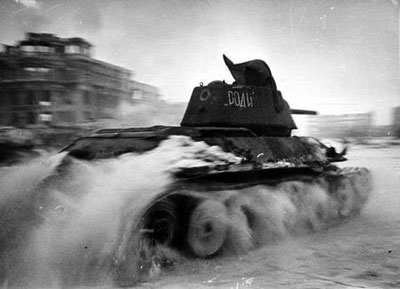 |
The encircled groups, under Mihail Lascar, despite giving some ground on their eastern flank still held down the majority of the Soviet rifle divisions. An all-out Soviet advance was therefore not possible. The 1st Tank Corps was still not participating in the exploitation movements and continued to battle with the German 22. Panzerdivision.
The German counterattacks were greatly hindered and ultimately prove fruitless. The reasons:
a) The three panzer divisions were withdrawn from Stalingrad piecemeal. It would have been necessary to withdraw them as quickly as possible. Part of the reason this did not happen was the whole extent of the Soviet offensive only becomes clear during the third day.
|
b) A coordinated counterattack with the combined forces of these combat groups was not possible, because the commanding corps, XIV Panzer, didn’t have sufficient information about the Soviet advance routes and the strengths of the forces opposed to them.
c) All German efforts were hindered by the retreating units and rear area services. Therefore it took the majority of the intended counterattack forces too long to reach their assembly areas and conduct sufficient reconnaissance before the attack. Also bad weather contributed a great deal to the difficulties the German reserve units had in their movements.
The German infantry divisions neighbouring the Romanian 3rd Army, 376. and 44., were forced to retreat and set up new defensive lines farther to the east. The movement of their retreating units also caused traffic problems for the German mobile forces.
Day Four, 22 November (live on 7 January 2010)...
|
Last Updated On Wednesday, November 18, 2009 by Wayne at Battlefront
|
|
|